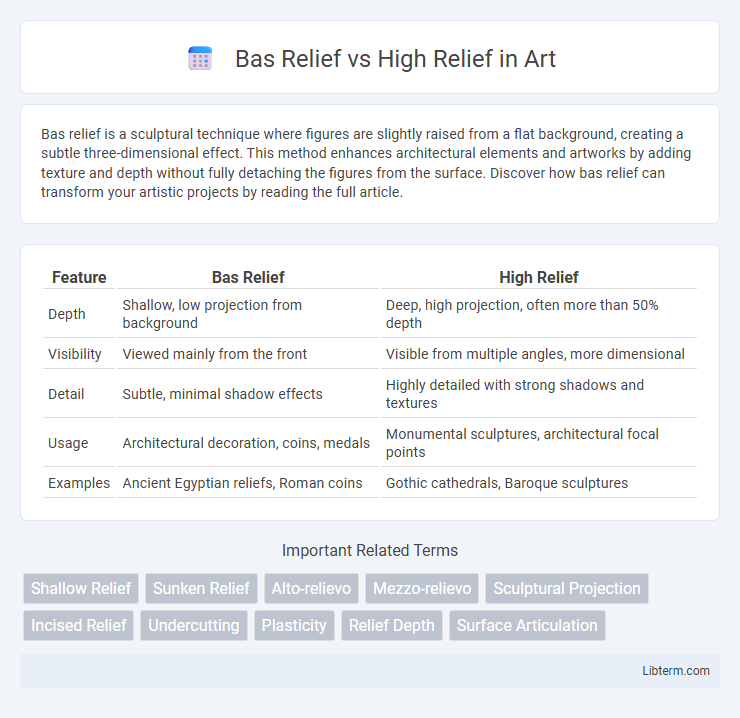Bas relief is a sculptural technique where figures are slightly raised from a flat background, creating a subtle three-dimensional effect. This method enhances architectural elements and artworks by adding texture and depth without fully detaching the figures from the surface. Discover how bas relief can transform your artistic projects by reading the full article.
Table of Comparison
| Feature | Bas Relief | High Relief |
|---|---|---|
| Depth | Shallow, low projection from background | Deep, high projection, often more than 50% depth |
| Visibility | Viewed mainly from the front | Visible from multiple angles, more dimensional |
| Detail | Subtle, minimal shadow effects | Highly detailed with strong shadows and textures |
| Usage | Architectural decoration, coins, medals | Monumental sculptures, architectural focal points |
| Examples | Ancient Egyptian reliefs, Roman coins | Gothic cathedrals, Baroque sculptures |
Introduction to Relief Sculpture
Relief sculpture is a technique where sculpted elements remain attached to a solid background of the same material, creating a raised surface that emphasizes depth and texture. Bas relief, or low relief, features shallow carving with subtle projection, often used for intricate details on coins, friezes, and architectural decorations. High relief involves deeper carving with elements that significantly stand out from the background, producing a more dramatic and three-dimensional effect commonly seen in monumental art and historical monuments.
Defining Bas Relief: Characteristics and Techniques
Bas relief, also known as low relief, features shallow carving where the sculpted elements remain closely attached to the background, creating minimal depth and subtle shadows. This technique emphasizes fine details and surface texture, often achieved through precise chiseling or engraving on materials like stone, metal, or plaster. Bas relief is commonly used in architectural decorations, coins, and commemorative plaques due to its ability to convey intricate imagery without projecting significantly from the base.
Understanding High Relief: Features and Methods
High relief sculpture features deeply carved elements that project prominently from the background, typically exceeding half of the object's depth to create dramatic shadows and a strong sense of three-dimensionality. This method requires skilled techniques such as undercutting and layering to achieve intricate details that stand out vividly from the mounting surface. High relief is commonly employed in monumental architecture and historical monuments to convey dynamic narratives and elevate visual impact through pronounced depth and texture.
Historical Origins of Bas Relief
Bas relief, also known as low relief, originated in ancient Mesopotamia and Egypt, where artists carved shallow images into stone surfaces to depict religious and historical narratives. This technique provided a durable and accessible medium for storytelling on temple walls, monuments, and tombs, emphasizing subtle depth rather than full three-dimensional forms. In contrast, high relief projects more prominently from the background, often approaching sculpture in the round, but bas relief's historical significance lies in its subtlety and widespread use across ancient civilizations.
The Evolution of High Relief in Art History
High relief, characterized by deeply carved elements projecting significantly from the background, evolved from the more subtle depth of bas relief to achieve greater dimensionality and realism in sculpture. This technique gained prominence during classical antiquity, particularly in Greek and Roman art, where it was used to depict dynamic narratives and emphasize dramatic shadows. Over centuries, high relief continued to develop, influencing Renaissance and Baroque artists who employed it to enhance emotional expression and spatial complexity in architectural and monumental works.
Key Differences Between Bas Relief and High Relief
Bas relief features shallow depth where sculpted elements slightly project from the background, creating subtle shadows and a flat appearance, while high relief involves deeper carving with figures prominently raised, often by more than half their natural depth. Bas relief is commonly used in coins, architectural friezes, and decorative panels, emphasizing intricate detail without significant three-dimensionality. High relief allows more dramatic, lifelike representations suitable for statues and monuments, enhancing visual impact through pronounced depth and shadow contrast.
Artistic Applications of Bas Relief
Bas relief, characterized by its shallow depth, is widely used in artistic applications to create intricate scenes on walls, coins, and architectural elements, enabling detailed storytelling with subtle shadows and textures. This technique allows artists to emphasize surface detail without the need for significant projection, making it ideal for decorative panels and narrative friezes in museums and historic monuments. In contrast to high relief, bas relief offers greater durability and versatility, especially in environments where delicate, low-profile embellishments are preferred.
Prominent Examples of High Relief Works
High relief sculptures feature deeply carved elements that project significantly from the background, creating dramatic shadows and a strong three-dimensional effect, exemplified by the intricate Parthenon Frieze in Athens. The Great Altar of Pergamon showcases prominent high relief details with dynamic figures that seem to emerge vividly from the stone. These masterpieces highlight the technical prowess and expressive potential of high relief, distinguishing them from the shallower, less protruding bas relief sculptures.
Choosing Between Bas Relief and High Relief in Modern Art
Choosing between bas relief and high relief in modern art depends on the desired depth and visual impact of the piece. Bas relief offers subtle dimensionality with shallow carving, ideal for intricate, detailed storytelling on limited surfaces, while high relief provides dramatic depth and shadow play, creating a more dynamic and expressive presence. Modern artists often select bas relief for architectural integration and high relief for standalone sculptures seeking to engage viewers through pronounced textures and forms.
Preservation and Restoration of Relief Sculptures
Bas relief sculptures, with their shallow depth, are generally easier to preserve and restore due to minimal surface protrusion, reducing exposure to environmental damage. High relief sculptures, characterized by deeper carving and more pronounced three-dimensionality, often face greater risks of physical deterioration and require more intricate restoration techniques to address structural vulnerabilities. Preservation efforts for both types emphasize careful cleaning, stabilization of material, and protection from weathering to maintain the integrity of the relief artwork.
Bas Relief Infographic

 libterm.com
libterm.com